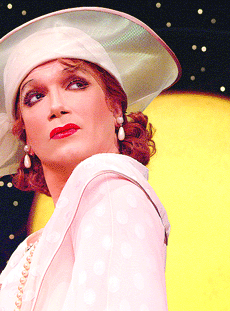Under the tresses and over the moon with leading lady Charles Busch
No one would dream of calling the aristocratic Charles Busch a drag queen. In a career spanning more than 20 years he has been a stand-up performance artist, actor, playwright, novelist, and, of course, leading lady in a string of high camp/low camp vehicles he wrote with titles such as “Vampire Lesbians of Sodom” and “Psycho Beach Party.” In most of these plays, Busch channels the glamorous female divas of the ‘30s, ‘40s, and ‘50s, including Joan Crawford, Norma Shearer, Rosalind Russell, and even Sandra Dee. His work isn’t parody; it’s homage. He inhabits his characters, and is both hilarious and witty. His work is filled with references to classic cinema; it’s not just about mugging, mannerisms, or God help us, lip-synching.
Busch fell in love with these stars while a child growing up in Ardsley, New York.
After his mother died when he was seven, his opera-loving father whetted his appetite further by taking him to see Joan Sutherland at the old Metropolitan. Charles was possessed by the glamour.
The documentary “The Lady in Question is Charles Busch” is a comprehensive chronicle of this beloved figure of the New York theater. In some ways, it’s a standard hagiography with talking heads and archival footage; but what other way is there when you have such an extraordinary person as the center of interest?
His fairy tale begins when his mother’s oldest sister Lillian Blum brings him to live with her in her Park Avenue apartment, and begins to supervise his education—moving him to the High School for Art and Music to realize his creative inclinations, and taking him to Broadway shows every other week. It’s a real-life Auntie Mame fable perfect for the young boy—except he is the flamboyant figure.
The film by first time directors John Catania and Charles Ignacio followed Busch around for five years, and opens with Busch’s triumphant premiere of “The Tale of the Allergist’s Wife,” which he wrote but did not star in. He based the characters on his family—particularly one sister—and they all express surprise that this quiet child was like a fly on the wall absorbing all he could.
Showing up in a tux for the event, Busch muses that it’s “just like a Hollywood premiere in the ‘30s.” He’s in his element, all right.
Things didn’t start out so glamorously. After leaving Northwestern University, Busch developed a one-man show, which he performed across the country for six years. He played garages, colleges, anywhere he could find a booking. The archival footage shows a handsome, curly-mopped performer giving his all ferociously on stage. The shag of hair has since disappeared.
A curious omission from the documentary is the absence of any reference to the great Charles Ludlum, whom Busch described as his mentor at a panel discussion at the Lesbian, Gay, Bisexual, and Transgender Community Center. Ludlum saw Busch’s work when he was still a stand-up performer essaying multiple roles in his one-man show and advised him to get rid of all the characters except the women. He also allowed him to perform midnight shows after Ludlum’s plays.
Busch says he began writing because he couldn’t get any jobs acting. He was considered by producers to be “too odd, too gay.” His travels led him to the nether reaches of the Lower East Side to an establishment known as the Limbo Lounge described in the film as a “crack den.” After viewing the so-called entertainment, he pitched an idea to the owner—“Vampire Lesbians of Sodom.” The owner accepted the offer on the spot. The hit show is credited with migrating the West Village gay community to the arts scene in Alphabet City.
The troupe, which included Julie Halston—whom Busch calls his muse—and Arnie Kolodner, as well as others, formed a theater group grandly advertised as the resident theater company of the Limbo Lounge. They called it Theater-in-Limbo and looked for a place to accommodate their growing audience. They needed $55,000 to open at the Provincetown Playhouse in the West Village, and somehow through handouts from friends and donations they came up with 300 donors. The play ran for five years, the longest running Off-Broadway play in New York history.
The documentary is well paced and contains rare archival footage particularly from “Vampire Lesbians,” including a scene in which Busch, playing a virgin to be sacrificed, escapes by mounting a centurion to take her maidenhead. The phenomenal success of “Vampire Lesbians” inspired Charles to mount a string of plays including “Psycho Beach Party,” “Times Square Angel,” “The Lady In Question,” and “Red Square on Sunset;” he’s always been good with titles. All played Off-Broadway and established Busch as one of the few theater artists running his own company, writing his own plays, and starring in every one.
After seven years,1984 to 1991, the Theater-in-Limbo—exhausted by non-stop performances and the death of troupe members from AIDS—fell apart. A fallow period of 10 years followed until the smash Broadway hit, “Tale of the Allergists Wife” catapulted Busch back into the limelight. Less than a year later Busch was diagnosed with a congenital heart disease and the doctors told him that most people with his condition die in a half hour or over the weekend. A seven-hour operation followed and he recovered fully. Busch responded to this episode in his life by creating a silent film especially for the documentary.
More recently, Busch wrote the American book for the transplanted London play “Taboo” starring Boy George and produced by Rosie O’Donnell. It was not a success, but he followed it up Off-Broadway with “Shanghai Moon,” and starred in “Die Mommie Die”—his first feature film as a leading lady.
May there be much more to come.
gaycitynews.com



































